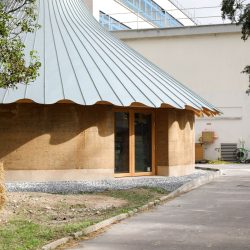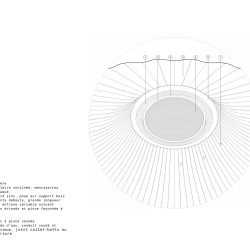
L’Atelier Senzu . photos: © Stijn Bollaert
The Le Vau Educational Pavilion crafter from wood and rammed earth stands as an exemplary project at the intersection of sustainable architecture and community engagement within a school complex in the 20th arrondissement of Paris. Conceived as a response to three critical challenges, envisioning architecture capable of considering both reception and pedagogy, fosters a connection between the school and its neighborhood, and significantly contributes to the imperative of decarbonizing construction practices.
This initiative materialized through the convergence of institutional efforts, namely the OASIS program and the participatory budget of the City of Paris, along with insights gleaned from the dedicated teaching team at Le Vau school. Recognizing a prevailing challenge in persuading parents to actively engage with the school, the team identified a palpable hesitancy and mistrust towards educational institutions. In response, the pavilion was envisioned as a transformative space to reshape perceptions and create a welcoming environment.
The OASIS program, dedicated to greening schoolyards to combat urban heat, played a pivotal role in this endeavor. The Le Vau school group, a beneficiary of the program, witnessed the transformation of vacant spaces into vibrant hubs, featuring vegetable gardens, orchards, and picnic areas. Inspired by the newfound opportunities for interaction, the idea emerged, within the framework of the participatory budget, to establish a distinctive educational space in the school courtyard.
As architects, our task encompassed a holistic approach, addressing the convergence of diverse concerns: accommodating dual functionalities within the architecture, fostering connections between the school and its surroundings, and prioritizing sustainability in construction methods.
With geometry, L’Atelier Senzu merged these three considerations and designed this innovative space. The synthesis of these considerations materialized in the form of a circular room, a departure from the conventional rectangular structures found in educational institutions. The circular design facilitates diverse, collective, and collaborative arrangements, promoting an egalitarian atmosphere. The facade draws inspiration from carousels or cabins, and the circular shape rejects the conventional hierarchy of main and secondary facades in favor of an all-encompassing design philosophy.
The choice of rammed earth as a primary material stem from its structural integrity, thermal properties, and aesthetic appeal. Utilizing geosourced, biosourced, and decarbonized materials, this project proudly claims the distinction of being the first load-bearing rammed earth building in Paris.
The pavilion, with its distinctive round shape, aesthetically pleasing design, strategic location bridging the street and the school building, and its innovative use of earth and wood, emerges as a welcoming haven for children and parents, a source of inspiration for educators, and a tangible contribution to climate goals for generations to come.
_































